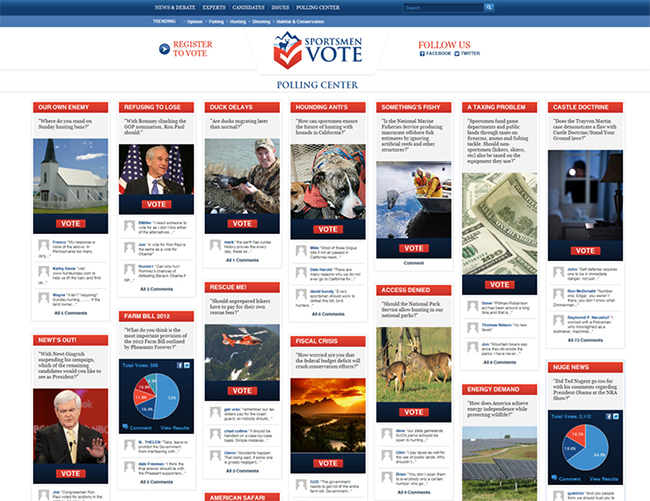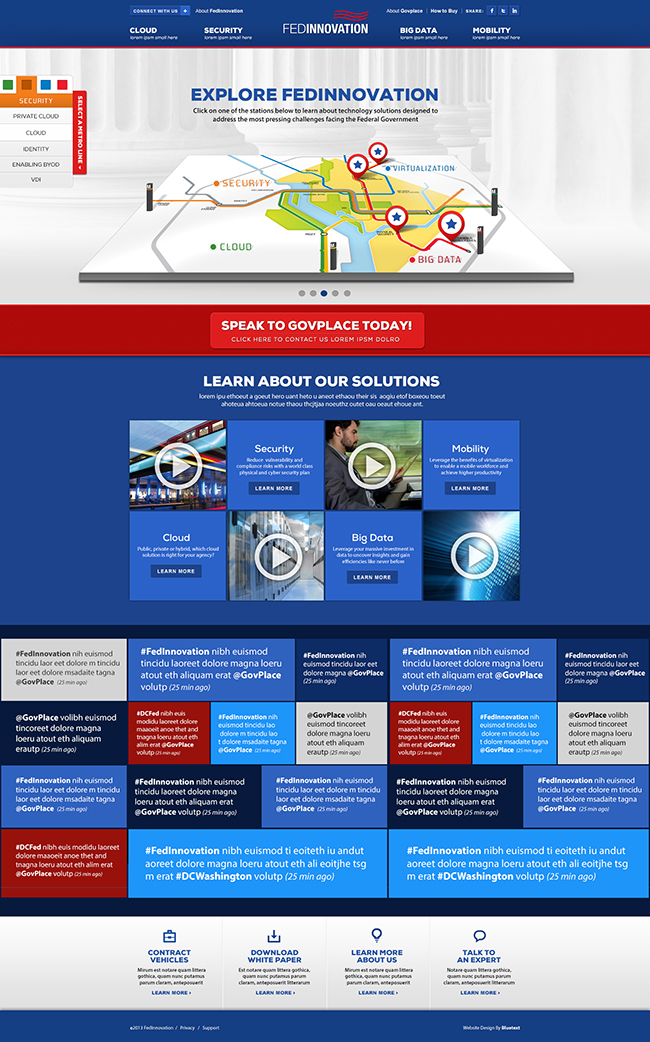Over the last five years there has been a lot written about the customer journey and the changing nature of how marketers must develop and present content to address a more informed customer with so many channels for gaining knowledge and insight into your product or service.
McKinsey recently found that 50% of all interactions for a customer happen during some multi-step, multi-event journey. That is why marketing automation platforms like Marketo, Pardot, and Eloqua have gained so much attention and momentum over the past few years.
At Bluetext, we are not in the business of recommending or optimizing marketing automation platforms. Anecdotally, what we hear and see from our clients and prospects is that while their enterprises are moving to these platforms, and there are technology consultants to help optimize them, the care and feeding of them with smart, relevant and consistent content is where they struggle.
Marry that with our belief that every online or offline interaction between an enterprise and their customers must deliver the same powerful, consistent brand attitude and message, and you see where we work with enterprises in the customer journey.
If you are struggling with how to deliver a clear, consistent and powerful message throughout the customer journey process, it is time to step up. You can rest assured that your prospects have noticed and have moved on to a competitor. Here are six baby steps that can make a difference in your 2015 execution.
1. Think Strategically, Not Episodically. When a client requests a quick ad or poster for an event that has just popped up, we always try to start with the why versus the what. Ask yourself the tough questions and push everyone around you to make sure that the output they are delivering helps tell your overall product or service story.
2.Is Your Content in Context? You have a new feature in your product, hired a new executive, or won a new contract…and you want to tell the world. Ask yourself so what? Why should the customer care? If the news is going to help you drive home an important message to your customer or prospect, go for it. If not, create content in the context of your customer’s pain points and ensure you hit those messages effectively.
3. Map Out Campaigns and Plans. Create Quarterly Campaign Themes that Can Drive Every Marketing Element You Plan to execute. Make sure these campaigns align with outside factors that are impacting customers, such as budgets or the seasons, and the direction of your enterprise product roadmap.
4. Deliver with Visual Impact. The world is changing. The white paper is getting replaced by infographics. Written blogs are getting enhanced with video. Are you making sure that when a customer sees anything from your organization, it is consistent and delivered with impact? Do customers get the same experience when visiting your website on their iphone as when they visit you at a breakfast seminar?
5. Put Your Customer First. Are you talking their language? Does your CTO talk about technology for the sake of technology, or how it will impact customers? If you put yourself in their shoes and stop drinking the kool-aid during your planning process, the end content and result will always be better.
6. Analyze. Analyze. Analyze. Not much needs to be said here. If you can’t measure it then you definitely can’t manage it.
Are you ready to step up your game in 2015? Whatever marketing platform you are using, you need to make sure that you are following these steps to take your prospects on a meaningful, contextual journey. We can help. Give us a call. Having an agency riding shotgun on this process can remove a lot of risk and ensure every deliverable is as impactful as possible.
On Friday night, Georgetown’s McDonough School of Business kicked off its alumni weekend with an awesome party under a tent outside the Hariri Building. Great food and great company were the hallmarks of the event. In keeping with the tight partnership Bluetext has formed with McDonough over the past two years through the design and build of McDonough’s new responsive website, msb.georgetown.edu, McDonough allowed Bluetext to set up a massive screen right next to the bar (a perfect place) to showcase the new website.
In turn, our team wanted to do something special for all of the alumni who returned. We are offering organizations of Georgetown McDonough School of Business Alumni a free digital marketing assessment, including website, SEO and Social. Interested alumni can reach us at msb@bluetext.com to learn more.
Thanks to Chris Kormis, Patrick Burritt and the entire team at McDonough school of business marketing and communications team for the ongoing partnership and relationship.
“Bluetext has been the ideal partner for the McDonough School of Business at Georgetown University. Our customer journey experience with this top notch agency was collaborative, creative, and technically sound. We are proud of the work Bluetext delivered to the school and we feel the results of the platform day in and day out.”
Chris M. Kormis
Chief Marketing Officer
McDonough School of Business

If you canvas the most respected marketing decision makers, each can no doubt share examples of bold, innovative marketing programs that did not work out. But the enemy of marketing innovation isn’t failure, its repetition; repeating the same approach again and again – even if the results do not meet expectations. As you sit down to create your marketing plan for 2015 and evaluate what worked and what came up short this year, here are six ideas to consider if you are not driving the amount of visibility, buzz and sales that you expect.
- Throw out the Baby with the Bathwater. Sometimes you need to cut your losses. A poorly designed website, a poorly received message, or a poorly produced video which cost a lot of money may be hindering your ability to market your company and get your message out. Be honest about what is working and be prepared to scrap that campaign which you spent a lot of money on.
- Put an influential name or face to your product or company. This is a strategy that has been written about extensively with clear results. Our clients have contracted with celebrities including Lewis Black, Joe Torre, and Frank Abagnale to put a face to their brand. The celebrity can be leveraged for a variety of activities, including social media, customer events, and immediate recognition across ads, etc. Please reference this blog post for more on this tactic – http://bluetext.com/celebrity/.
- Sometimes the Local is the Way to Go. The content marketing train is zooming across corporate America, much to the displeasure of the PR budget. It is not the only way to get to your destination however. PR has a very important place within every marketing budget. While many consider it to be an old school tactic, the validation you can receive from a well-placed story about your product or service can be worth 10x the investment if done right. My partner Brian Lustig will be writing about this in a blog post next week.
- Go Out on a Limb with a Sponsorship. How many times have you said that my company does not have the budget to do a major sponsorship? Take a step back to look at the number of events you have sponsored with a lame table top to appease a sales representative where no viable leads came out of it. Those costs add up. Take that money and do sponsored Tweets, webinars or branded social properties, or sponsor a well-known organization that will create some buzz for your company. This can be measured in many ways and is often used to put a company, product or service on the map.
- Zig When your Market is Zagging. The best marketers are known for executing bold campaigns to stand out in crowded markets. How bold are you willing to go? Are you marketing to save your job or get your next one? I was in a pitch the other day where the CEO of a start-up SaaS company talked about taking on an entire industry.
- Go Mobile First. Anyone that tells you that you don’t need to worry about mobile visitors and site traffic has ocean front property in South Florida to sell you. Sure, we can all look at the analytics and it is true that data trumps opinion, but mobile is only getting more popular and the user experience should be well designed for a mobile world. Responsive design is clearly the direction that the industry is headed and one that you must deploy to stay relevant for the long term.
Are you ready to get started? Are you ready to break new ground with your marketing program? Don’t look now but unless your foot is on the pedal then your competitors will leave you in the rear view mirror…and that is not a place that most marketers want to be.
Supporting CSC’s global digital brand team, Bluetext designed and built CSC’s Digital Briefing Center, a virtual experience where clients and CSC’s entire ecosystem can come to learn about CSC’s key technology conversations across its target verticals.
As the company expands with a global customer base and diverse set of solution offerings, it was important to ensure that prospective customers could get a similar experience as they would if they visited corporate HQ.
Bluetext designed a virtual office building where each floor represents a specific vertical industry, and visitors can learn about CSC’s key solutions and experience across cloud computing, big data, applications, cyber security, and mobility.

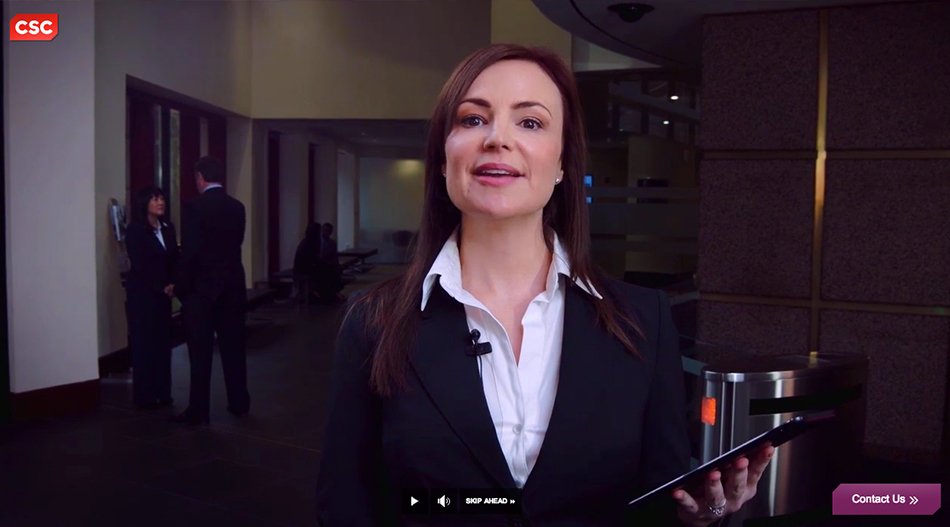

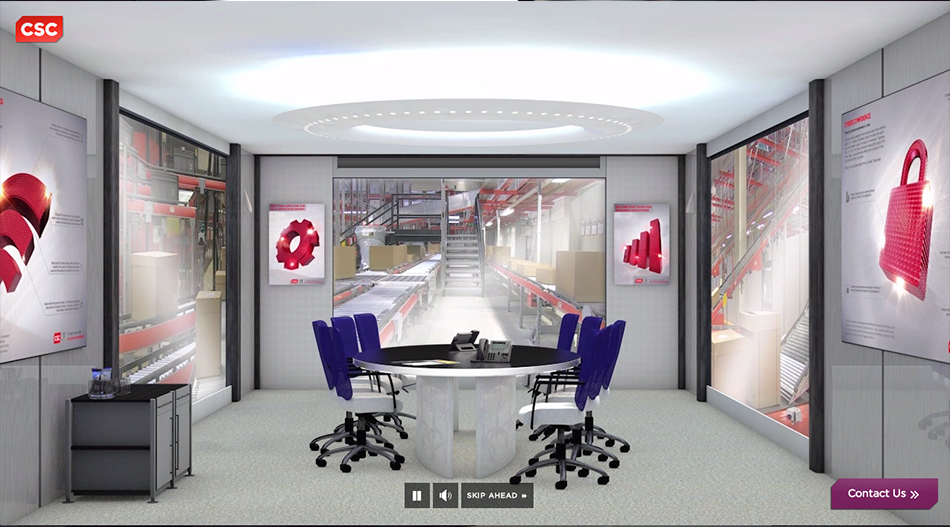
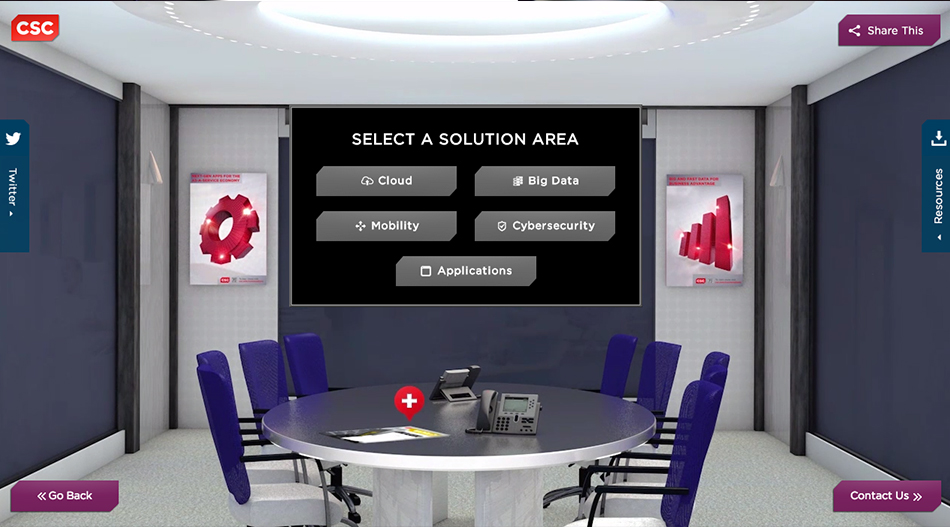

The highlight of the Digital Briefing Center is the elevator ride where users can see “CSC” in action across healthcare, banking, manufacturing, and insurance. The solution is designed to scale with more solutions and target industries, as well as partner ecosystem solutions from CSC’s top technology partners.
It was built for users across all browsers. For pre-HTML5 browsers we built a lightweight code base, and for today’s modern browsers we used HTML5, a custom video player, and a JSON XML Twitter integration. Bluetext handled all CMS integration into CSC’s environment.
An emerging trend across business-to-business marketing is its “consumerization.” As customer expectations shift and their buying habits change, businesses that sell and market to other businesses are stealing tactics from “businesses to consumer” marketers.
Tried and true b2c marketing strategies such as user engagement, personalized content, rich media, gamification and alignment with offline events are increasingly nudging their way into b2b digital campaigns. This shift is not lost on businesses, advocacy groups and trade associations, which are all leading the charge in adapting consumerized marketing tactics to a business customer audience. They are creating digital communities to effectively tell their story, sell their products, and gain traction for their issues. These communities are designed to make complex messages more consumable, mobilize user or advocacy groups, and provide users the opportunity to join or “own” the conversation.
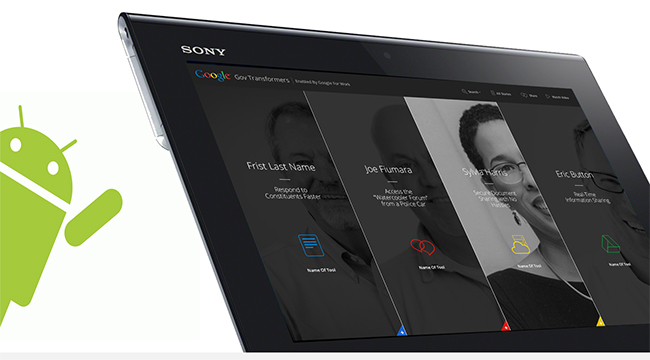
At Bluetext, our approach to developing and executing digital marketing campaigns for clients is to not be bound by conventional battle lines of business, consumer and government. Each market is surely unique, but by remaining open to innovative tactics and strategies we are consistently able to help clients’ marketing efforts stand out from the pack. Based on recent projects, we have assembled a set of core recommendations for any business or organization seeking to leverage the consumerization of b2b and advocacy marketing to impact customer buying decisions and brand awareness.
Drive Personalized Content and Experiences
By stepping back and letting your best customers and members take the lead in telling your story, the content becomes more real and personalized. One example is a campaign Bluetext developed for Google called GovTransformers that showcases a wide variety of public servants and how they are using Google’s enterprise applications. The campaign shines a spotlight on dozens of government workers all across the United States – from law enforcement to CIOs – with video profiles, photographs and written descriptions. By making customers the heroes, other customers are encouraged to share their stories.
We leveraged offline events to grow the community with a series of Hackathons in key cities around the country. Each Hackathon brings together programmers and developers over a weekend to help solve digital challenges using any developer tools they want, as long as one of Google’s enterprise apps is also part of the solution. For example, at the Denver Hackathon, one of the challenges involved automating the Colorado Disaster Assistance Center. Another challenge included designing a transparent budget data system for the state of Wyoming.
Enable Users to Join the Conversation
Giving stakeholders an easy way to join the conversation keeps them engaged and an active part of the community. We have built polling ecosystems for several clients that can span a portfolio of brand sites to access their opinions across a number of relevant issues, while giving them a platform to collect and contextualize the trends of the community through data visualizations.
For Intermedia Outdoors Network, a leading publisher of magazines for hunters, fisherman and outdoor enthusiasts, we created SportsmenVote with a Pinterest-type of format offering various issues in the form of questions that have “yes” or “no” or multiple choice answers. The results can be displayed in real-time, and a comment section is built in for those who want to expound more on the topic. The results provide an ongoing reason for the community to return to the site and engage in the dialogue, with content ready to be shared in a social “snackable” format.
Showcase Your Most Important Assets –Users
Showcasing stakeholders in their own element can be a powerful way of growing a community. The Forest Landowners Association represents families who harvest wood products from privately-owned forests that they manage. Sustainability is a key component of their effort to preserve these private forests. To help build a community of like-minded landowners with a common interest in these issues, we built a platform called Forest America. It serves as a news repository and a recruitment tool for advocacy purposes, complete with impactful videos and a simple way for families to submit their profiles.
Don’t Be Boring. Engaging Concepts & Content to Educate the Market
Govplace turned to Bluetext to develop FedInnovation, a destination designed to help government agency executives get the latest information on current technology challenges and solutions for big data, cloud, security, mobility and storage. Developed in conjunction with leading technology providers including Dell, Intel Security and VMWare, it includes exclusive content, videos, blogs, and real-time social feeds. From this platform, Govplace will drive blog posts, webinars, and other marketing programs to ensure its target audience understands the value that it, working with the leading IT providers to the Federal Government, can deliver.
Get Game
We are not talking about the next Grand Theft Auto or Call of Duty. But think about your audience and determine whether a game would engage them. Games can also throw off a lot of “social shrapnel” to drive content and interest. For Lucent Government Solutions (LGS) we designed a “Words with Friends” meets Scrabble experience to help recruit new engineers and drive awareness for the solutions they are delivering into the market.
Join the Cause – Everyone Wants to Take Action
Building a digital platform to showcase a community won’t be of much help if it’s not easy for new members to participate. We recommend offering opportunities to participate directly on the site, either through submitting your own story, taking a poll, seeking information and insight from other members of the community, or using an advocacy tool to weigh in with policy makers. What is essential is having well placed calls-to-action throughout the site so that visitors do not have to search for ways to participate. New Twitter tools like Tweet Builder increase a brand’s reach to its social properties by connecting with influencers whose posts then tie back into the digital platform. This social engagement extends the brand far beyond a single website to a wide variety of social sites.
The consumerization of b2b marketing is not about trying to fit a square peg in a round hole; instead, it represents the fact that forward-thinking businesses and organizations across every market recognize a fundamental shift in how business customers are accessing content and information, and what types of marketing initiatives will impact their buying decisions.
The Cloud continues to be one of the hottest technology themes across all enterprise organizations, and that’s no different for government agencies at the Federal, state and local levels. Then-U.S. Chief Information Officer Vivek Kundra even announced an Administration-wide “cloud first” policy three-and-a-half years ago requiring agencies move some of their systems to a cloud-based service, and while budgets are in flux, that remains a priority for agencies. I read a recent article from IBM around top technology trends shaping the government’s future, and cloud computing was right behind mobile devices at the top of the list.
While there are conflicting reports across the public sector regarding the extent to which spending Cloud spending will grow in the near term, there is no uncertainty that the underlying spend figure is massive. As a result, companies in the cloud services business face opportunities and challenges in effectively marketing their offerings to federal agencies.
At the top of the list of challenges that makes government agencies a tough sell when it comes to moving to the cloud is security. Agencies require assurances on who has access to and controls their data, and about how they will get it back if a cloud provider goes out of business, is acquired or simply disappears. Messaging that works for the commercial sector might not resonate with government executives, while concepts around hybrid approaches might be a better solution.
My partner Don Goldberg recently wrote a blog post around Ten Tips for Marketing to the Government. Thinking about cloud service providers, some of these apply. Here are five that really need to be considered:
1- Dedicated Government messaging that is clear and easy to find is essential. Agency decision-makers will not sort through corporate messaging to discern what might be important to them.
2 – Speak the language of Government. Their needs are different than the needs of commercial enterprises. Understand their pain points and realize that mandates and mission requirements are driving a lot of the decision making. At the same time, don’t become consumed in ‘defensive messaging.’ In other words, companies become so sensitive to agency cloud concerns that messaging assumes a defensive posture that attempts to negate pre-conceived notions around security and control. These pain points are important, but don’t lose sight of putting forward positive messaging on all the benefits the Cloud can deliver.
3- Easy-to-find government specific landing pages are a must. If decision makers don’t quickly find information that is directly relevant to them, they will move on to a competitor’s website. We all too often find government subpages buried deep into a site, and masked with an all too obvious government façade that will only serve to completely negate the hard work of your sales and field marketing teams dedicated to this market
4 – Get involved in the community. If you are just getting started and don’t have case studies, getting involved in the community is important. Carpet baggers don’t succeed selling to the Federal government. It takes a dedicated, focused effort and commitment to the community.
5 – Think about many marketing avenues to get your message out. Buying some radio or sponsoring one event is not enough. Work with specialists who understand the government market and how to drive an integrated message into it – the impact of your spend will be easy to measure.
At Bluetext, getting the messaging right before we execute any campaign or strategic endeavor is critical. We had a great meeting this week with a prospective client to discuss our approach to messaging in advance of a large rebranding effort. They have spent a lot of time inside their own walls discussing the right words to describe the business. We compiled some thoughts on the inputs required to develop an effective messaging platform. Here are six areas to think about for developing a corporate messaging platform. I am sure that others have many more to add. Would love other thoughts you have that may be missing here?
- Get the inside perspective. Talk to executives, customer facing staff, and other staff who can provide valuable insight into product, solution or strategy.
- Get the outside perspective. Talk to partners, customers, and prospective buyers to understand their needs and preferences.
- Make sure your messaging is a direct response to a clear and measurable market challenge. Use your research to ensure there is a clear and measurable market challenge; make sure that your messaging can address the “so what” factor.
- Conduct an analysis of how your competitors are messaging to identify opportunities to drive differentiation.
- Ensure your messaging speaks commandingly not only about who you are and why people should care, but also provides a market perspective to drive thought leadership; customers like working with thought leaders.
- Don’t forget to perform an SEO analysis to ensure word choice and structure align with the words the market is searching for.
Contact me at michael@bluetext.com to discuss your messaging challenges.
2013 was the year where CMOs could test drive new campaigns, collaborating with their CIOs to leverage technology and provide better measurement and metrics for these new approaches. In 2014, CMOs will no longer be able to kick the tires and take their campaigns out for a spin. Results need to be proven. Every click will be analyzed, and every dollar will be scrutinized.
Ok, time for a little context. People throw around the CMO word very liberally. Many of our clients are not marketers at the c-suite level – often they are directors of field or industry marketing. While they are supposed to use Eloqua or Marketo or LeadLander or any variety of engagement tools, the further they sit from the corporate marketing function or headquarters the less their campaigns seem to get measured. It is easy to do a webinar or event, report back to corporate that the campaign generated 200 “leads,” and then move onto the next campaign.
For years we have talked about the fact that, because of the nature of most campaigns living in a digital world, any activity is easy to measure, evaluate, and evolve. Unfortunately many clients don’t take that to heart. They work hard to launch a campaign, turning to Bluetext for great creative and execution as well as new ideas, but then they move onto the next one before it is fine tuned. In 2013, we had a number of clients who launched campaigns, looked hard at the metrics, and despite huge kudos from their corporate offices, decided not to just sit back and relax. Instead, they are devoting new resources to evolve the campaigns to address changing market conditions and feedback. On our end, we are ensuring that clients are giving the proper financial and time resources to drive traffic and leads for their campaigns so there is no question about their effectiveness and impact.
I think this is a trend that will continue in 2014. CMOs and, more importantly, field and industry marketing leaders will take the time to analyze and measure their campaigns leveraging new technology. And they will course correct as needed.
Before shaking your head and wondering if this is a blog post that you read 12 or 24 months ago, take a step back and think about how much time and effort you are really putting into measuring your campaigns. Many of the people we work with would be hard pressed to look in the mirror and say that they are leveraging metrics to truly validate their campaigns and spend. Our goal in 2014 is to change that for our clients.
Critical Elements to address when thinking about a re-brand?
- Do you really know the audience you want to influence with your brand and what they think of your company? If the answer is, “We think so but are not 100% sure or in agreement,” start with research into your customers and prospects to understand your brand starting point. Determine the channels they use to interact with your brand. Do they visit your site via a mobile device but you have not optimized for mobile?
- Don’t rebrand for the sake of re-branding. What are the corporate goals you are trying to accomplish? Are you launching a new product or service line? Have you slowly transformed your market but your current customer base does not know it? Do you need to energize your employee base?
- Analyze and agree upon your story and message. Many people can design a great logo, but it is the story behind the logo and brand initiative that is critical.
- Use the rebrand as your chance and excuse to re-introduce yourself to current customers.
- Think about all the brand elements to drive consistency. A new logo without a matching website experience, family of templates, new business cards, office signage, etc. can really fall flat. Make sure you design a corporate style guide that is strictly followed across the board, and can be expanded to business partners and other audiences.
- Start with your internal audience to roll it out. Your employees are your number one brand ambassadors. If they are excited about the brand and message you will immediately have a fleet of people ready to share it.
- Measure the impact of the rebrand. What are the key performance indicators you are measuring? Are you getting more meetings? Are you getting more website visitors? Is there a better understanding of your brand six months after launch? 12 months?
- Is your rebrand designed to scale as you enter new markets or expand with new products?
- Are there international considerations now or in the future related to your brand that you need to address?
- As you think about all of these, remember that planning is critical. A strongly mapped out strategy will get you the required results you desire for your brand.
I heard a little story the other day that made me smile. One of our earliest clients, which selected Bluetext for a digital platform and website overhaul as well as marketing and social media strategy, has seen their business go through the roof since executing the campaign with us. What makes me happy is that this client was very hesitant to spend the money, skeptical about the potential results, and had never done any impactful marketing. Thinking back to this early project, I think it’s instructive to explore why working with this reluctant client turned out so well.
First, we did our homework on its industry and competitors, and designed a digital platform that demonstrated to the market that it was serious about the future and committed to the business of its customers. As a rule, when designing websites and digital platforms, you have to understand the user experience, how your customers interact with your business, and what they can and should expect when working with you. Many businesses organize their websites around how they operate instead of how their customers want to consume content. And many businesses think that a new website is merely lipstick on a pig.
Second, the client spent the money on a custom photo shoot, which we strongly recommended and helped to execute, as its products lend themselves to having their customers see them and get a clear sense for what they are going to get (as opposed to, for example, a software product). Sometimes, creating a sense of something tangible in the digital world can be very important.
Third, it got aggressive with social media in a market where it originally believed it was not important to prospects. The client committed for the long haul to develop new content and push it out via all channels.
Everyone wants happy customers that benefit from the work you do for them – in this case, a major investment which was met with skepticism has significantly benefitted the bottom line. That is the kind of success that makes me and the entire Bluetext team smile.

